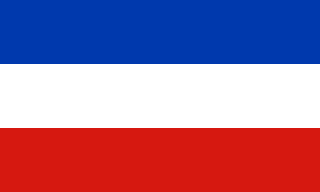
Schleswig-Holstein is the northernmost of the 16 states of Germany, comprising most of the historical Duchy of Holstein and the southern part of the former Duchy of Schleswig. Its capital city is Kiel; other notable cities are Lübeck and Flensburg.

Steinburg is a district in Schleswig-Holstein, Germany, administered from Itzehoe. It is bounded by the districts of Dithmarschen, Rendsburg-Eckernförde, Segeberg and Pinneberg, and by the Elbe River.
Pinneberg is a district in Schleswig-Holstein, Germany. It is bounded by the districts of Steinburg and Segeberg, the city of Hamburg and the state of Lower Saxony. The island of Heligoland is also part of the district.

Herzogtum Lauenburg is the southernmost Kreis, or district, officially called Kreis Herzogtum Lauenburg, of Schleswig-Holstein, Germany. It is bordered by the district of Stormarn, the city of Lübeck, the state of Mecklenburg-Vorpommern, the state of Lower Saxony, and the city state of Hamburg. The district of Herzogtum Lauenburg is named after the former Duchy of Saxe-Lauenburg.
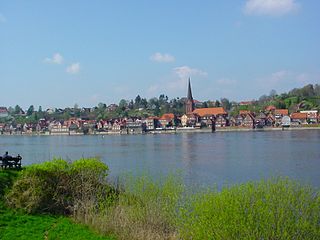
Lauenburg, or Lauenburg an der Elbe, is a town in the state of Schleswig-Holstein, Germany. It is situated on the northern bank of the river Elbe, east of Hamburg. It is the southernmost town of Schleswig-Holstein and belongs to the Kreis (district) of Herzogtum Lauenburg.

Harburg is a borough of the city of Hamburg, Germany. It is also the name of Harburg quarter in the borough, which used to be the capital of the Harburg district in Lower Saxony. The borough of Harburg lies on the southern banks of the river Elbe and covers parts of the port of Hamburg as well as residential and rural areas. It had a population of 169,221 as of 2020.
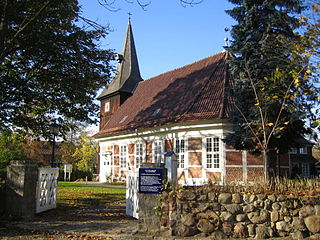
Geesthacht is the largest city in the District of the Duchy of Lauenburg in Schleswig-Holstein in Northern Germany, 34 kilometres (21 mi) south-east of Hamburg on the right bank of the River Elbe.

Büchen is a municipality in the district of Lauenburg, in Schleswig-Holstein, Germany. It is seat of the Amt Büchen.

Lütau is a village in the district of Lauenburg, in Schleswig-Holstein, Germany. It is situated approximately 7 km north of Lauenburg/Elbe, and 40 km east of Hamburg.

Wilhelmsburg is a quarter (Stadtteil) of Hamburg, Germany within the borough (Bezirk) of Hamburg-Mitte. It is situated on several islands between the Northern and Southern branches of the Elbe river, together with the other quarters of Steinwerder, Veddel and Kleiner Grasbrook. The latter almost exclusively consists of facilities of the port of Hamburg. In 2020 the population was 53,064.

Finkenwerder is a quarter of Hamburg, Germany in the borough Hamburg-Mitte. It is the location of the Hamburg Airbus plant and its airport. In 2016 the population was 11,668.

Heist is a municipality in the district of Pinneberg, in Schleswig-Holstein, Germany.

Geest und Marsch Südholstein is an Amt in the district of Pinneberg, in Schleswig-Holstein, Germany. The seat of the Amt is in Moorrege.

Cranz is a quarter in the Harburg borough of Hamburg, Germany. It is on the left bank of the Elbe river and one of the 104 quarters of Hamburg. In 2020 the population was 843.

Altengamme located in the Bergedorf borough of the Free and Hanseatic City of Hamburg in northern Germany, is a rural quarter on the right bank of the Elbe river. Altengamme is the most eastern part of Hamburg. In 2020 the population was 2,362.

is a district in the borough of Altona within the Free and Hanseatic City of Hamburg in North Germany. In 2020 its population was 11,352. Iserbrook belongs to the Elbvororte.

Jutland is a peninsula of Northern Europe that forms the continental portion of Denmark and part of northern Germany (Schleswig-Holstein). It stretches from the Grenen spit in the north to the confluence of Elbe and Sude in the southeast. The historic southern border river of Jutland as a cultural-geographical region, which historically also included Southern Schleswig, is the Eider. The peninsula, on the other hand, also comprises areas south of the Eider: Holstein, the former duchy of Lauenburg, and most of Hamburg and Lübeck.

Harburg is a quarter (Stadtteil) in the Harburg borough (Bezirk) of Hamburg, Germany. It used to be the capital of the Harburg district in Lower Saxony. In 2020, the population was 25,979.
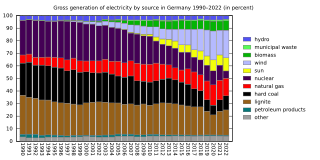
Germany's electrical grid is part of the Synchronous grid of Continental Europe. In 2020, due to COVID-19 conditions and strong winds, Germany produced 484 TW⋅h of electricity of which over 50% was from renewable energy sources, 24% from coal, and 12% from natural gas. This is the first year renewables represented more than 50% of the total electricity production and a major change from 2018, when a full 38% was from coal, only 40% was from renewable energy sources, and 8% was from natural gas.
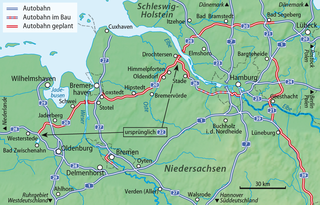
The Elbe crossing is a planned fixed transport link across the lower Elbe between Hamburg and the North Sea. The crossing is expected to enable the westward extension of the coastal Bundesautobahn 20 to join Bundesautobahn 26 and on to Bremerhaven and the Weser tunnel. The link is planned to cross the Elbe between Glückstadt in Schleswig-Holstein and Drochtersen in Lower Saxony, to form part of the North West Bypass of Hamburg and improve the road connections along the Amsterdam–Copenhagen transport corridor. This is a joint project of the states of Lower Saxony and Schleswig-Holstein. The crossing is proposed to be a 6.5-kilometer (4.0 mi) tunnel under the Elbe, and is expected to cost about 1.3 billion euros. If the tunnel is built, it would be the second longest road tunnel in Germany.






















